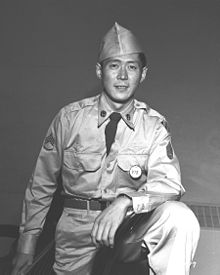Hiroshi Miyamura
Hiroshi H. Miyamura (October 6, 1925 – November 29, 2022), also known as Hershey Miyamura, was a United States Army soldier. He received the Medal of Honor because of his actions in the Korean War.[1]

- In this Japanese name, the family name is Miyamura.
Early life
changeMiyamura was born in Gallup, New Mexico to Japanese immigrant parents. He is a Nisei, which means that he is a second generation Japanese-American.[2]
Soldier
changeMiyamura joined the US Army in January 1945.[3]
Miyamura volunteered to be part of the all-Nisei 100th Infantry Battalion.[4] This army unit was mostly made up of Japanese Americans from Hawaii and the mainland.[5]
After the end of World War II, he became part of the U.S. Army Reserve. He was called to active duty in the Korean War. He was a prisoner of war for 28 months.[6]
Medal of Honor citation
changeMiyamura's Medal of Honor recognized his conduct in frontline fighting in Korea in 1951. He fought in close quarters combat; and he stayed behind to provide covering fire while his unit withdrew.[1]
The words of Miyamura's citation explain:
Cpl. Miyamura, a member of Company H, distinguished himself by conspicuous gallantry and intrepidity above and beyond the call of duty in action against the enemy. On the night of 24 April, Company H was occupying a defensive position when the enemy fanatically attacked threatening to overrun the position. Cpl. Miyamura, a machinegun squad leader, aware of the imminent danger to his men unhesitatingly jumped from his shelter wielding his bayonet in close hand-to-hand combat killing approximately 10 of the enemy. Returning to his position, he administered first aid to the wounded and directed their evacuation. As another savage assault hit the line, he manned his machinegun and delivered withering fire until his ammunition was expended. He ordered the squad to withdraw while he stayed behind to render the gun inoperative. He then bayoneted his way through infiltrated enemy soldiers to a second gun emplacement and assisted in its operation. When the intensity of the attack necessitated the withdrawal of the company Cpl. Miyamura ordered his men to fall back while he remained to cover their movement. He killed more than 50 of the enemy before his ammunition was depleted and he was severely wounded. He maintained his magnificent stand despite his painful wounds, continuing to repel the attack until his position was overrun. When last seen he was fighting ferociously against an overwhelming number of enemy soldiers. Cpl. Miyamura's indomitable heroism and consummate devotion to duty reflect the utmost glory on himself and uphold the illustrious traditions on the military service.[1]
Namesake
changeAn area in Gallup, New Mexico was named for Miyamura[7] The Hiroshi H. Miyamura High School is named after him.[8]
An I-40 highway interchange is also named after him.[9] It is also called the Miyamura Overpass.[7]
Related pages
changeReferences
change- ↑ 1.0 1.1 1.2 US Army Center of Military History (CMH), "Medal of Honor Recipients, Korean War" Archived 2009-03-10 at the Wayback Machine; retrieved 2012-12-24.
- ↑ Japanese American Veterans Association, "The Nisei Legend of the Korean War"; retrieved 2012-12-24.
- ↑ U.S. National Archives and Records Administration (NARA), WWII Army Enlistment Record #39868194 (Miyamura, Hiroshi); retrieved 2012-12-24.
- ↑ Go for Broke National Education Center, "About Us, Veterans Honor Guard" Archived 2012-10-28 at the Wayback Machine; retrieved 2012-12-24.
- ↑ "100th Battalion, 442nd Infantry" at Global Security.org; retrieved 2012-12-24.
- ↑ Bartelt, Eric S. "Secret Hero Recounts his Unforgettable Korean War," Special to American Forces Press Service, April 24, 2001; retrieved 2012-12-24.
- ↑ 7.0 7.1 "Land Use Element". Archived from the original on 2013-05-06. Retrieved 2023-01-22.
- ↑ "Hiroshi Miyamura High School - Homepage". web.archive.org. Archived from the original on 2012-03-06. Retrieved 2023-01-22.
- ↑ "Master Report". web.archive.org. Archived from the original on 2016-03-03. Retrieved 2023-01-22.
Other websites
changeMedia related to Hiroshi H. Miyamura at Wikimedia Commons